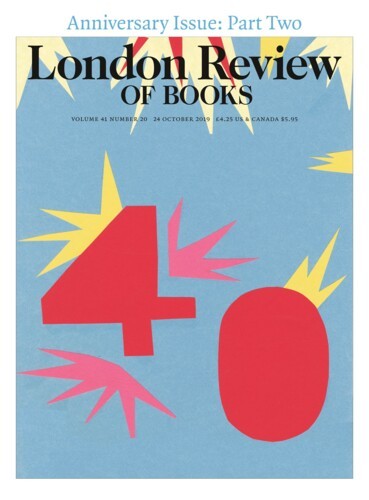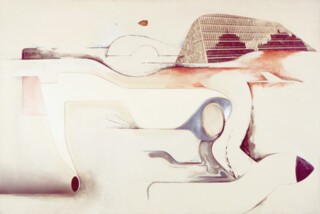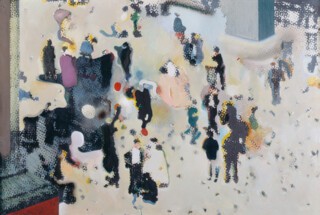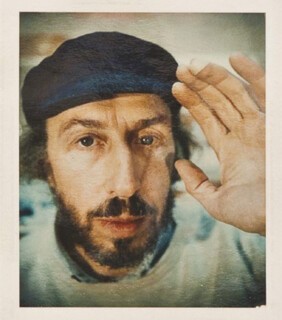Biographies of artists often read like legends of heroes. Vasari preferred his Renaissance masters to be precocious in talent, humble in origin and, if possible, anointed by a predecessor – so he gives us Cimabue discovering the shepherd boy Giotto sketching a pastoral scene with perfect skill. Born in 1922, Richard Hamilton was a working-class kid whose gift for drawing was recognised early on: at 12, he talked his way into adult classes, and at 16, not long before the Second World War, into the Royal Academy of Art. Yet, as we might expect of this ‘father of Pop’, his story comes with Futurist twists: his earliest memories include the thrill of riding in sports cars with his father (whose job it was to break them in for rich clients) and of coming across brand names like Pan Yan Pickle at the shops (no rustic themes for this urban artist). For all his traditional training in anatomy and perspective, Hamilton was committed to modern life from the start. At 15, attracted by the building’s abstract façade, he asked for a job at Reimann Studios, an art school cum design company modelled on the Bauhaus. During the war he served as a jig and tool draughtsman. For Hamilton, paintings and products, art and design, were complements, not opposites, and he liked to fold them together in his work.
Hamilton resumed at the Royal Academy in 1946, only to be expelled by a reactionary faculty – he had dared to prefer Cézanne to Augustus John. Forced into national service for 18 slack months, he spent most of the time reading, Joyce above all, and Ulysses became the subject of a first suite of etchings; old media attracted him as much as new. ‘Hamilton was fascinated by the skill, the virtuosity and the outrageous power of the command of language that gave Joyce the freedom to employ every trick of his trade with a confidence that could absorb parody and pastiche into the poetic flow of words,’ Phillip Spectre (we’ll get to him later) tells us. ‘The question that needed to be asked was, why had such a phenomenal freedom and mixture of styles not appeared in the visual arts?’ Hamilton made more than a hundred illustrations of Ulysses over his lifetime, most of which focused on the ‘Oxen of the Sun’ chapter, in which Joyce rehearses the history of English literature. Hamilton never completed the project, but it was a signal experience nonetheless. It supported his belief that ‘the painter need not be committed to a personal style’ – a lesson underscored by Marcel Duchamp, his other great inspiration – but that ‘fragments of image’ could be ‘freely quoted’ in a single work. It also announced his commitment to printmaking, which he pursued in a recursive relay with painting: ‘There is often an interrelationship between a print and a painting for which it serves as a study, or even a copy, but occasionally a subject is so firmly bound to the medium of print that it sits in isolation.’ Finally, it led to his first curatorial effort, a gathering of Joyce materials, including some of his etchings, at the new Institute of Contemporary Arts in 1950, for which Hamilton also designed the poster and the catalogue (this too became his customary practice). Soon he would treat the exhibition as an art form in its own right, as did other colleagues in the Independent Group, which began to meet at the ICA two years later.
In 1948, in a final foray into formal study, Hamilton entered the Slade, where he met two future IG cronies, Eduardo Paolozzi and Nigel Henderson. He was especially fond of Henderson, whom he found ‘well educated, quick-witted and streetwise, on friendly terms with just about everyone worth knowing in the art world of London, and blessed with a generosity of spirit that he showed by sharing his privileged status with charm and good humour’. Henderson introduced Hamilton to Roland Penrose and Lee Miller, the power couple who both supported the IG and exposed Hamilton to Duchamp – most importantly, to The Green Box, the book of notes detailing the making of The Bride Stripped Bare by Her Bachelors, Even (1915-23), a.k.a. The Large Glass. At this time, too, together with Paolozzi and Henderson, Hamilton began to haunt natural history museums, to comb through glossy American magazines, and to look at encyclopedic scholarly texts, all in search of sources for individual pictures as well as entire exhibitions. In this quintessential IG undertaking, which can be seen as a pre-emptive counter to the ‘two cultures’ thesis advanced by C.P. Snow in 1959, two treatises stood out above all others: On Growth and Form (1917) by the Scottish polymath D’Arcy Thompson, which inspired Hamilton to curate an exhibition in 1951 of various images of natural morphologies; and Mechanisation Takes Command (1948) by the Swiss architectural critic Sigfried Giedion, which in 1955 prompted Hamilton to undertake a survey of disparate pictures of human-mechanical hybrids on the ground, in the air and under the sea.
Hamilton began to produce paintings dotted with organisms such as sea urchins, drawn from Thompson, and prints devoted to machines such as agricultural reapers he found in Giedion. He believed that the ‘rigorous causality’ evidenced in the evolution of organic and mechanical forms ‘might be applied to the vagaries of art’, might, that is, help to motivate the pictorial image in new ways; even as Hamilton acknowledged the breakdown of academic figuration, he couldn’t accept the limitations of pure abstraction. A third text, The Perception of the Visual World (1950) by James J. Gibson, ‘a study of how motion affects a viewer in a three-dimensional space’, also played an important role in his art-making (Duchamp was interested in such questions too). During this period Hamilton spent many hours on the train from London to Newcastle, where Lawrence Gowing had hired him to teach; this helped to pay the bills that his art couldn’t yet cover. (At this point Hamilton had two young children with his first wife, Terry, who died in a car accident in 1962.)
For Hamilton, 1956 was a watershed year. The celebrated exhibition This Is Tomorrow was staged at the Whitechapel in the summer, and although it wasn’t strictly an IG event, it dramatised the concerns of the group clearly enough. The Brutalist wing of the IG was represented by the team of Paolozzi, Henderson and the architects Peter and Alison Smithson, who littered a bare shed on a rough patio with symbolic relics (it looked as though it had been ‘excavated after the atomic holocaust’, the critic Reyner Banham remarked). On the proto-Pop side of the IG were Hamilton, John McHale and the architect John Voelcker, who contrived a fairground ‘crazy house’ on the theme of the new sensorium produced by mass media; among other images and objects, it featured a sci-fi robot, a jukebox, ‘a lifesize cut-out figure of Marilyn Monroe in the legendary scene from the film The Seven Year Itch in which her dress is blown by the draught from a subway vent’, and ‘a giant papier mâché bottle of Guinness’. The most consequential work associated with the show was also the smallest, the collage Just What Is it That Makes Today’s Homes So Different, So Appealing?, produced for the catalogue by Hamilton with the help of his wife and the artist Magda Cordell out of pictures cut from American magazines – Life, Look, Good Housekeeping and Scientific American. In this tiny tour de force, whose title is taken from a full-page advertisement for linoleum that provided the interior setting of the image, a bodybuilding Adam and a hair-perming Eve preside over a paradise of consumer products and mass entertainments. One of the iconic pictures of 20th-century art, it summed up what ‘Pop’ meant even before the term was in circulation.
This Is Tomorrow marked the end of the IG, but its dissolution allowed Hamilton to focus on his own art. His ‘tabular pictures’, in which ‘fragments of image’ are ‘freely quoted’, soon followed. He tells us that ‘1956 was a vintage year for the great names of the American automobile industry,’ and Hommage à Chrysler Corp., a smooth commingling of curvaceous car and body parts, is his first riff on a new type of commercial styling that spiked commodity fetishism with sexual fetishism. Here ‘the dream car of the 1950s grew breasts and was judged on its rear end.’ While Hommage presents a luxury product gendered female from the outside, Hers Is a Lush Situation (1958) – the title is another line from an advert – imagines what it would be like to drive alongside Elizabeth Taylor in midtown Manhattan (the windshield is a picture of the United Nations building turned on its side). Hamilton produced a few more semi-figurative combinations of sexy commodities and commodified women in a sustained attempt ‘to capture those moments when the eyes, as in a swoon, lose control’. Although he viewed his tabular paintings as ‘a demonstration of support for feminism’, he acknowledged that ‘the feminists were not amused.’ He also thought the works were more ‘ingenuous’ than ironic: ‘It looks as though the painting is a sardonic comment on our society. But I would like to think of my purpose as a search for what is epic in everyday objects and everyday attitudes.’ Here Hamilton aligns his project with ‘the painting of modern life’ according to Baudelaire, whose famous line – ‘By “modernity” I mean the ephemeral, the fugitive, the contingent, the half of art whose other half is the eternal and the immutable’ – Hamilton updated as his own pictorial credo. Like Paolozzi and McHale, he felt that art had to produce new ‘archetypes’ – to reclaim this traditional role from mass culture – or die.
The tabular pictures project a theatre of heterosexual male desire in which the bride is stripped by her bachelors but never possessed by them. In this way they are an indirect reflection on The Large Glass, which preoccupied Hamilton at this time. He devoted some three years to the complex task of transliterating the Green Box notes, which was a key contribution to the intensive reception of Duchamp in the 1960s, and this study confirmed not only his belief in the impersonality of the artist but also his model of the artwork as a ‘pictorial essay’ or dreamy rebus that the viewer must puzzle out. Well into his eighties Hamilton referred to Duchamp as his mentor, despite veering away from his example often enough. Although Hamilton also valued artistic detachment, his hand was ‘very active in execution’, and although he too adopted a cerebral approach, his forte was ‘retinal painting’, which Duchamp rejected. At the same time they shared an ambiguous attitude towards both fine art and popular culture, which Duchamp called an ‘ironism of affirmation’ and Hamilton a ‘peculiar mixture of reverence and cynicism’. The close association had other effects as well. In 1963 Hamilton accompanied Duchamp to his first retrospective in Pasadena, California, where Hamilton met Andy Warhol and Claes Oldenburg (who became a good friend); in 1966 he collaborated on another Duchamp survey, at the Tate, the centrepiece of which was his own painstaking reconstruction of The Large Glass (the fragile original couldn’t travel from the Philadelphia Museum of Art).
For a time after his American sojourn Hamilton shifted from passive female figures to active male subjects. In Towards a Definitive Statement on the Coming Trends in Men’s Wear and Accessories (1962) – another tagline from a magazine, in this case Playboy – he reviewed the ‘different realms’ of ‘space, sport [and] virility’, with pictures of the astronaut John Glenn, an American football player, a track and field athlete, and President Kennedy. What does it mean, the series implicitly asks, that such men are role models? Do they count as sex objects too? Next Hamilton moved from individual figures to crowd scenes, as in Whitley Bay (1965) and Trafalgar Square (1965-67), both based on enlarged postcards with colour overlays and paint daubs added to suggest tentative groupings. The paintings reprise an Impressionist question: how has modern leisure affected such traditional genres as landscape and cityscape? And they add a Pop query: is class now subsumed by mass? In one painting, entitled simply People (1965-66), the source image is ‘magnified to a stage where the medium is no longer able to carry the image’. Like Antonioni’s film Blow-Up, which it predates by a few months, People invites us to question the truth value of photographic representation in a way that theorists such as Roland Barthes had only begun to do.
Hamilton mostly stuck with ‘classic subjects for art’ such as ‘the interior, the nude, landscape, seascape, still life, portrait, flower-piece, and mother and child’, but he always filtered them through popular forms such as adverts, movies, postcards and commercial design. How is still life altered by the inclusion of industrial products? How has fashion photography affected the conventions of the nude? In the 1970s this most anal of artists indulged in a ‘scatological period’ during which he dropped ‘gigantic turds’ at the bottom of kitschy floral arrangements and resplendent sunsets. It is hard not to see them as playful swipes at Hans Arp and Henry Moore; they also seem to parody the notion that our first painting is our infantile smearing of poo, a psychoanalytic cliché that, thanks to Piero Manzoni and others, had become an avant-garde one as well.
Often this collision of high and low was a matter of appropriation, or what Duchamp called ‘assisted readymades’. In Still Life (1965), Hamilton took a photograph of an electric mini-oven from a Braun brochure and simply changed the brand name to ‘Brown’. In Toaster (1966-67), he claimed another Braun product, added a wash of colour, and rechristened it a ‘Hamilton’. In a similar vein he remade a Ricard carafe, ashtray and enamel sign, turning each into ‘Richard’ with the addition of one letter. This genre of ‘art as consumer product’, which Hamilton celebrated, could also be a complicated affair: Lux 50 (1979) is ‘a two-dimensional image of a radio with components that could function well acoustically and also perform silently as a depiction of itself’.
On such occasions ‘Hamilton approached an aesthetic problem with recourse to his experience as an engineer’. In the mid-1960s he struggled to transform a favourite advert depicting the changing of an automobile tyre between 1902 and 1950 into an exact perspectival diagram; in the end it took an early computer to pull off the trick. During the same years he executed a ‘building portrait’ of the Guggenheim’s great spiral in six fibreglass reliefs fabricated with the help of a car parts company (five were spraypainted like bonnets, one was gold-leafed like an icon). Always an early adopter of advanced equipment, Hamilton asked fellow artists to take his picture with the recently released Polaroid camera; the result, Polaroid Portraits (1968-2001), was a series of 128 photographs that ‘spanned the history’ not only of this ‘instant camera’ but also of three decades of his own appearance. He was an early adopter of computer programs too, and after 1987 all his ‘prints and paintings utilised, in a variety of ways, digital image-processing equipment’.
Throughout his career Hamilton proceeded by way of polarities, a ‘stratagem of dichotomy’ that he credited to Duchamp, but his purpose was to demonstrate how such oppositions as the epic and the everyday, traditional genres and popular forms, and art and technology, were more apparent than real. He even tried to ease a tension that lay deep in the historical avant garde between the anti-institutional impulse of Dada (apart from Duchamp, Hamilton was an advocate for Kurt Schwitters, whose Merz Barn in the Lake District he helped to save) and the constructive pedagogy of the Bauhaus (he had close ties to the Bauhausian Hochschule für Gestaltung in Ulm). By the same token his practice was animated by such tensions. For all his intensive work in the studio, Hamilton was also responsive to political events, which he addressed in a range of works, from his 1964 portrait of Hugh Gaitskell as a movie monster through his iconic image of the fallen student murdered by the National Guard at Kent State in 1970, and on to his extraordinary pictures concerning the Troubles in the 1980s (these were influenced by the commitments of his second wife, the artist Rita Donagh). This last suite of images – of a hunger striker, an old Orangeman and a young soldier – counts as contemporary history painting on a par with the representations of the Baader-Meinhof gang produced by Gerhard Richter during the same period. In a very late painting, Hamilton presented Tony Blair as a Wild West cowboy, and he left a project concerning the Occupied Territories unfinished at his death.
In the end Hamilton was animated by this tension above all: even as he embraced the postwar world of spectacle, he aimed to ‘open up an apparently seamless media image or event to analysis through a variety of print media and painting techniques’ – that is, to deconstruct its pictorial construction. Neither reverence nor cynicism, then, neither complicity nor critique, but both at the same time. This tension points to a further one between his investigation of many media and his privileging of painting above all, between his eclectic imagery and his singular style, between his career as a ‘succession of projects’ and his process of self-critical revision. Against all expectations, Hamilton positioned painting not as the quintessentially old medium, but as a meta-art that could, all at once, carry forward such precious devices as perspective, raid popular culture for myth-making subject matter, and – because of its static nature, not in spite of it – reflect critically on photography, film, digital images and other new media. ‘I’ve always been an old style artist,’ Hamilton acknowledged in 1967, ‘a fine artist in the commonly accepted sense: that was my student training and that’s what I’ve remained.’ Strange words for a father of Pop, but true enough.
Then there is his writing. Hamilton not only designed but also wrote many of his catalogues, and his Collected Words (1982) remains the best study of his work up to that point. He revised and reused his texts as much as he did his pictures; he once called them ‘a poetic parody, a pastiche that attempts to match with words’ what he had ‘struggled to create visually with paint, collage and photography’. To this end, like his friend Banham, Hamilton produced a distinctive kind of Pop prose, which, even as it resembled the gonzo journalism of Hunter S. Thompson, Tom Wolfe and others, also recalled the rambunctious mix-and-match of images and ideas in the IG, with a lingo that is excessively mimetic of a brash consumerscape of bright but broken surfaces. In this light Hamilton and Banham were madder men than any copywriter on Madison Avenue at the time.
So who is Phillip Spectre, the author of Introspective, which I have quoted from so liberally here? He is an alter ego for Hamilton, a device which made it possible for him to write his memoir in the third person; he told me once that his initial title for the book was Autofaction, a nice anticipation of contemporary autofiction. This double is also a final nod to Duchamp, who created his alter ego Rrose Sélavy – as in ‘Eros, c’est la vie’ – to open a little more space for the staging of his art. Along these lines what might ‘Phillip Spectre’ connote? I doubt Hamilton meant it as an homage to Phil Spector, the record producer turned convicted murderer – though they both liked to lay down complicated tracks in the studio, and the allusion wouldn’t be beyond his wicked sense of humour. Maybe Hamilton intended the name to conjure up ‘a lover of ghosts’, that is, of all the spectral figures that appear in his work. Certainly it is like him not only to write his own biography (he was a control freak to the end) but also to haunt his afterlife in this way (modest though Hamilton was, he was confident of his place in any future Lives of the Artists). The final pages of Introspective are indeed spectral: the text breaks off in the 1990s, even as the images run on till his death in 2011. As Duchamp said of The Large Glass when it was accidentally cracked, Introspective is ‘definitively unfinished’, and there is real pathos in these blank spreads. But then, restless as Hamilton always was, I can imagine him even now tinkering with his Ulysses prints, retouching his tabular pictures, seeking out new titles for pieces on websites, trying out the latest computer, or revising this very memoir in the weirdly welcoming bardo that is his art history.
Send Letters To:
The Editor
London Review of Books,
28 Little Russell Street
London, WC1A 2HN
letters@lrb.co.uk
Please include name, address, and a telephone number.




